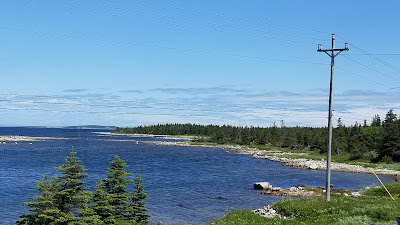#32 Port au Chois to St. Barbe
July 18, 2019
The road led to dark
green forests and interesting color in the flat mountains. The dark areas in
the mountains are rock strata. I
wondered if that was a building in the crevice, but a closer look indicated it
was two snow fields around rock.
The sun shone
brightly as we followed the Gulf of St. Lawrence. The water lapped the shore in shades of blue
and green. White salty waves splashed
against the rocky shore line.
Some areas looked like a lumber yard. We made
many assumptions as to who cut it, who used it, who paid for it, etc. What we learned from our museum guide is that
all of the piles are privately owned. No
one can store enough wood at their houses, so they get a permit to pile them where they can.
Apparently everyone knows who owns what.
No one touches another man’s wood pile.
We passed one of the
many little communities along the road. I happened to capture a fisherman
fishing in the river.
Viking Trail Academy
educates the children in this area. It
is a K-12 facility. I spoke with three
girls from there when we toured the 50 Century Museum in Bird Cove. This looks very typical to other academies we have seen.
Puddles and ponds
continue to fill in the low areas of land. The one next to the wall of rock
looked heavy with iron.
Liked this shot of
the gulf.
The turn off to St.
Barbe came at this corner. As we came
into town we spotted our first iceberg.
Only 180 people call St. Barbe home.
This RV park is a parking lot surrounded with chain link fence. It is literally a “parking lot” as most tourists
leave the rigs here and just take a car over to Labrador. Met some interesting people here and on the
ferry and in Labrador. You bump into each other at the different sights and
restaurants. We also got our first glimpse of an iceberg here.
After setting up,
Derrille and I headed for Bird Cove.
This sign made me laugh. I wonder
why they chose this short stretch of highway to add this warning. About 98% of the roads show weather wear with lots of potholes.
The 50 Centuries
Interpretation Centre of Bird Cove was just a bit south of St. Barbe. A very knowledgeable young lady gave us a
guided tour. She is a college student in
Thunder Bay with ambitions to become an anthropologist and forensic
scientist. One other helper there is
going to college in Corner Bay and majoring in business. I think the third young lady just graduated
in June from grade 12 and I don’t know her plans.
In the rock
collection of fossils and old rock this one interested me. Our guide said it may have been a grave
marker. I’ve never seen anything quite
like it.
This fossil sat at
the bottom of the sea. Therefore the
foot impression must have come from a sea creature. The dark rock with the notches is thought to
be a calendar of sorts.
The limestone
pavement felt so smooth, like glass. On our return from St. Anthony back down the this highway, I spotted several areas with the limestone pavement on the beach.
I liked this Einstein
quote.
This full Minke whale
skeleton washed ashore and men brought it in pieces to the museum where it was
assembled. It is one of the few full
skeletons. The Minke is one of the
smallest baleen whales being only 25 feet long. However it also claims to be
the most abundant. Like all baleen whales it has two blowholes.
When Captain Cook
came to the area, he charted the land. This represents his original shoreline
map, which is quite accurate. This rock
cairn that Captain Cook built in 1754 on the shore here still stands. Local people know not to touch it, and
visitors are told to do the same. One of
the amazing things about this area is no one bothers or destroys pieces of
history or other people’s things. They
just don’t. How nice is that!
Check out this garden
we passed by. It was next to their home.
125030 121823
We have seen gardens
along the highway in areas without visible housing. We have learned these plots operate like the wood
piles. When the highway was built the good top soil was moved to the sides of the road. Since good soil is hard to fine here, people get permits and put in gardens next to the road.
LOL Just another house with a front door and storm
door and side panel, but no way to reach it. Remember regulations require 2 entries, but no porch is required for both, so it saves money and material to do without.
Labrador Tomorrow!









































































































